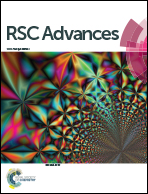Solid-phase extraction coupled with ultra performance liquid chromatography tandem mass spectrometry to determine seven halogenated salicylanilides in cosmetics
Abstract
A solid-phase extraction (SPE) purification coupled with ultra performance liquid chromatography tandem mass spectrometry (SPE-UPLC-MS/MS) method was developed for simultaneous determination of seven halogenated salicylanilides (including 3,3′,4′,5-tetrachlorosalicylanilide, 4′-bromosalicylanilide, tribomsalan, dibromsalon, metabromsalon, 5′-bromo-4′-chlorosalicylanilide and 5′-chlorosalicylanilide) in cosmetics. Samples were firstly extracted using dichloromethane and purified by an amino (NH2) SPE cartridge. The target analytes were separated by a Waters UPLC™ HSS T3 (100 mm × 2.1 mm, 1.8 μm) column and subsequently detected through an electrospray ionization (ESI) source in the negative mode with multi-reaction monitoring (MRM) conditions. An external standard method was adopted for the quantification. Finally, validation of the proposed method was performed in terms of linearity, limits of detection (LOD), selectivity, matrix effect (ME), accuracy and precision. Under the optimized conditions, linear relationships were favorable over the selected concentration ranges of 0.5–200.0 μg L−1 for all the seven analytes, with correlation coefficients (R2) greater than 0.997. The limits of detections (LODs) were in the range of 1.5–2.5 μg kg−1. Recovery experiments were conducted at three concentration levels spiked in two kinds of cosmetics (cream class and water class). The average recoveries were calculated between 83.9% and 107% with relative standard deviations (RSDs) of 2.9–6.5% for intra-day precision (n = 6) and 4.9–7.0% for inter-day precision (n = 5). The validated method was successfully applied to determine the concentrations of halogenated salicylanilides in thirty complex cosmetics samples, and dibromsalan (DBS) and 3,3′,4′,5-tetrachlorosalicylanilide (TCSA) were detected in two samples with the concentrations of 584 μg kg−1 and 422 μg kg−1, respectively.


 Please wait while we load your content...
Please wait while we load your content...